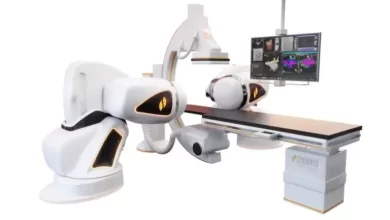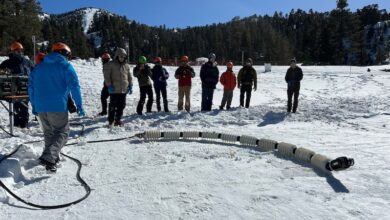NK robotics team heads to worlds



Zach DiBiase, left, oversees a STEM workshop last week in the makerspace at North Kingstown High School. Leading the five-week program for middle school students was his senior project. As a member of the GONK Squad, which qualified for next week’s world robotics championship in Houston, he was tasked with outreach. PHOTO BY ANDREA VON HOHENLEITEN
Two local teenagers are among a group of students from North Kingstown High School who are bringing their robot to a worldwide competition next week in Texas.
The GONK Squad won the Inspire Award at the Rhode Island FIRST Tech Challenge Championship at the New England Institute of Technology in February. That award qualifies the team for the FIRST Championship from April 17-20 in Houston.
“Our goal in robot performance is to be competitive,” said Rick Powell, a teacher who has mentored the program since it was established in 2007. “But what I’m looking for in this case is for the students to have an enjoyable experience that they will remember for the rest of their life.”
Powell, who also coordinates the school’s engineering program, said 2024 is the third time one of the school’s teams has qualified for the world championships. The program has more than 50 students participating on seven teams, and the GONK Squad is considered the varsity team. Quinn O’Connell and Zachary DiBiase represent Jamestown on that top team.
The North Kingstown teams compete in the FIRST Tech Challenge in a division that is open to students in grades 6-12. Students at Lawn School compete in the associated FIRST Lego League.
In the FIRST Tech Challenge, students learn to design and build a motorized robot out of parts, like an Erector set. These robots then compete against other teams’ creations in a game. The competition changes annually and the students begin creating their robot for the season after the theme is released in September. The robot competes in the same game at all levels of competition.
In this year’s Centerstage game, teams competed with their robot inside of a 12-foot-by-12-foot playing field as part of two alliances, with each having two robots. In the game, there are two periods: one in which the robot is controlled by the driver and the other in which the robot is programmed to operate autonomously.
“They have to pick up these plastic hexagons and bring them to the opposite side of the field and place them on a platform,” Powell said, “They try to get bonus points for how they arrange them based upon color and how high they can place them.”
At the end of the game, Powell said there is another opportunity to score bonus points by suspending their robot off the ground and shooting a paper airplane onto the field. The bonus points would be determined by which zone the airplane lands.
In the autonomous section of the game, the team receives points for the robot completing those tasks by itself. The teams are judged on design, engineering, performance, documentation and community outreach.
O’Connell, who drives the robot and helped build it, said their robot has five main mechanisms. That includes the drivetrain, which he said helps the robot move around, and the intake for collecting the game elements. Then there is the outtake, which lifts and deposits the elements, and the drone launcher that shoots the paper airplane.
“And the linear actuators that lift up a set of hooks and allow the robot to hang off the ground,” he said.
Although O’Connell said robotics is “really fun,” it can get stressful at times during competition. Practice makes perfect, however, to prepare the team for those contests.
“We learned to operate it through a lot of practice,” he said. “We spent hours getting used to the controls and running practice matches in order to get comfortable with how the robot moves and what it can do.”
DiBiase said his role this year was outreach and organization as opposed to operating the robot. He created STEM activities for elementary and middle school students and sought out local industry partners for collaborations.
Among DiBiase’s outreach events was a three-week STEM camp last summer and three community STEM nights during this school year. He also led a five-week after-school program that introduced local seventh and eighth-graders to the high school’s opportunities.
“I chose to focus on outreach this year because it is always rewarding to see younger students excited about learning STEM,” he said. “I enjoy creating interactive engineering lessons.”
Although he didn’t work much with the robot this year, DiBiase said he is looking forward to participating in the world competition and watching the other teams from around the world.
“Every member of our team has put in so much time and effort into this season,” he said. “We are excited to be able to represent Rhode Island at the world competition. It will be a great opportunity for us to take inspiration from other teams so we can continue to improve our strategy in the coming years.”
Since the state championship, the students have built a different robot to compete that has a refined design from their previous one. Powell said the new robot is “smaller, faster and can reach higher.”
“We made our design more compact and changed the mechanisms used for raising the game elements upwards,” O’Connell said. “We replaced our slides with longer ones that would allow us to raise the game elements higher and added a chain and sprocket system to deposit the game elements onto the game board.”
For instance, there is a truss across the field the robots must go under, and their new robot is not as tall and is more maneuverable. The team kept its original robot together so it could model its world championship entry on it.
The team will leave Monday for Houston and will be interviewed by the judges Wednesday. During the trip, the GONK Squad will visit NASA’s Johnson Space Center.




